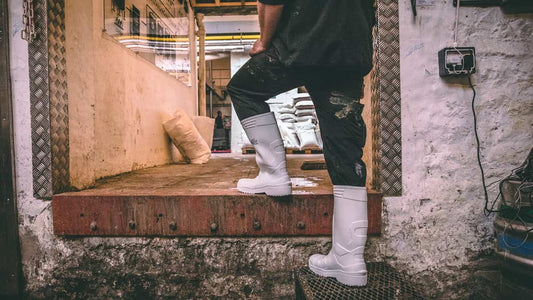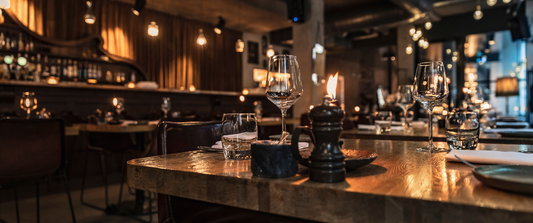OUR GUIDE TO NON-SLIP & SLIP-RESISTANT SHOES AND HOW THEY WORK
If you work in food service, catering, health care, construction or manufacturing, you're probably no stranger to spills and the potential hazards they can cause. According to the HSE, slips, trips and falls make up 44% of all workplace injuries making them responsible for many workplace accidents.
However, there are steps you can take to mitigate the chances of a slip or fall. For example, opting for footwear with a slip-resistant sole will help to avoid any unnecessary slips or accidents. But how do slip-resistant shoes work? We'll take a closer look below.
- What are non-slip shoes?
- How do non-slip shoes work?
- Non-slip vs slip-resistant shoes
- What is the GRIP rating scheme?
- Additional features and benefits of slip-resistant shoes
What are non-slip shoes?
Non-slip shoes, also known as slip-resistant shoes, are shoes designed to minimise the risk of a slip or fall due to a slippery or wet surface. At first glance, slip-resistant shoes look like any other kind of shoe. The difference lies in the design of the sole and tread of the shoe. Through specially adapted features, the outer sole of the shoe aims to increase friction, resulting in a better grip and traction on the surface of the floor.
How do non-slip shoes work?
Slip-resistant shoes work by utilising three design features to improve friction between the outer sole of the shoe and the surface of the floor.
1. The shape of the outsole tread
Slip resistance relies primarily on the design and pattern of the tread on the outsole. If your shoes have a flat design, it prevents the liquid from moving away from the base of the shoe so when you're walking, you're more likely to slip.
By utilising a hexagonal or circular pattern, water isn't trapped under the sole.Instead, the water displaces between the grooves of the sole allowing them to get a better grip on the floor.
2. Deeper grooves
Deeper grooves along the outsole of the shoe provide higher friction against the surface of the floor. On average, the friction you gain for each tread groove ranges between 0.018 to 0.108. However, this will depend on the condition of the floor you're walking on. As a general rule, the more grooves you have on your shoes, the more slip-resistant the shoes are.
3. The material of the sole
The material of the tread on slip-resistant shoes also aids against slips and trips. High-grade rubber has proved successful at gripping on greasy surfaces and provides strong traction.
Non-slip vs slip resistant shoes
Non-slip and slip resistant are terms that are used interchangeably. Whilst the features of slip-resistant shoes mitigate the chance of a slip or fall, they cannot guarantee protection all of the time.
That being said, through rigorous testing, the level of protection that slip-resistant shoes can offer compared to standard footwear is unmatched and should always be a consideration for those who work in industries where spills and slippy surfaces are commonplace.
What is the GRIP rating scheme?
The Health and Safety Executive (HSE) introduced and developed the GRIP rating scheme to allow for individuals to identify and compare slip-resistant footwear.
Through rigorous testing under the GRIP scheme, footwear is awarded a star rating between one and five. The level of protection correlates with the star rating. For example, a two-star rating would be suitable in environments where slips happen but are infrequent. Footwear with a four or five-star rating would be most suited to environments where slips are common.
The chosen footwear should always be informed by a risk assessment and monitored continuously. If you have opted for footwear with a low star rating but have continued to experience slips, then you should consider upgrading to footwear with a higher rating.
Additional features and benefits of slip-resistant shoes
In addition to providing protection against slips, you'll also find that non-slip shoes offer other features and benefits to provide extra comfort and stability. Many designs will often include cushioned insoles, padded collars and arch support to encase the foot and prevent fatigue and aches.
Slip-resistant shoes can also be made out of lightweight materials to ensure they don't put a strain on the wearer's feet, ankles and legs. At Shoes for Crews, we've engineered a foam compound that makes our shoes lighter which aids against pain and discomfort.
With our TripGuard technology, footwear from Shoes For Crews features a small curved lug at the front of the shoe which reduces the chances of tripping.
As slip-resistant shoes are designed to be worn in environments where spills are common, many also feature water-resistant materials which can keep your feet safe and dry. We have also developed a SpillGuard membrane which we've engineered into the upper materials of our shoes.
What makes Shoes For Crews outsoles work so well against slipping?
Shoes for Crews products use a unique compound on the sole of their shoes which gives them a premium slip-resistant grip. The high-grade rubber and micro-channel tread increase friction which aids against the chances of a slip or fall. The design of the tread displaces water under the shoe to allow for the tread to get a better grip on the surface of the floor.
Shop for slip-resistant shoes at Shoes for Crews
Opting for slip-resistant shoes is a great way to ensure your safety at work whilst also giving your feet the comfort and protection they need. At Shoes for Crews, our entire range of footwear has been awarded the Five Star GRIP rating so you can be confident that you're taking the best steps for avoiding any trips or slips in the workplace. You'll find a range of options and styles to suit a variety of different industries and professions.



